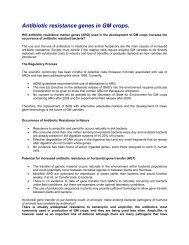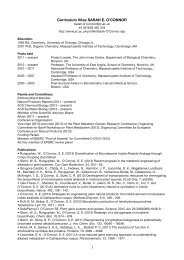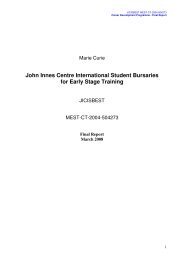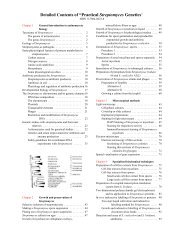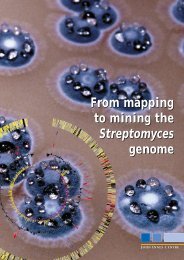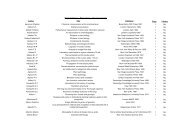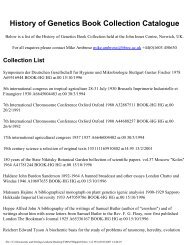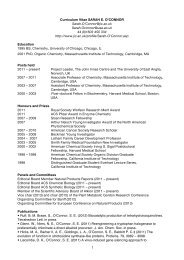A novel meta-cleavage product hydrolase from Flavo - ResearchGate
A novel meta-cleavage product hydrolase from Flavo - ResearchGate
A novel meta-cleavage product hydrolase from Flavo - ResearchGate
You also want an ePaper? Increase the reach of your titles
YUMPU automatically turns print PDFs into web optimized ePapers that Google loves.
676 S. Khajamohiddin et al. / Biochemical and Biophysical Research Communications 351 (2006) 675–681<br />
We now report that the open-reading frame, orf243,<br />
encoded in the organophosphate degrading (opd) gene cluster<br />
of plasmid pPDL2 of <strong>Flavo</strong>bacterium sp. ATCC27551<br />
encodes an MFP <strong>hydrolase</strong> that shows high affinity for<br />
both ketone and aldehyde group-containing <strong>meta</strong>-fission<br />
<strong>product</strong>s. We have consequently designated this open-reading<br />
frame mfhA (<strong>meta</strong>-fission <strong>hydrolase</strong> A).<br />
Materials and methods<br />
Bacterial strains and culture conditions. Cultures of Escherichia coli and<br />
Pseudomonas aeruginosa PAO1161 were grown in LB medium at 37 °C<br />
and 30 °C, respectively. When necessary, antibiotics such as ampicillin<br />
(100 lg/ml), chloramphenicol (30 lg/ml), and kanamycin (25 lg/ml) were<br />
added to the growth medium.<br />
Construction of plasmids. To express MfhA with an N-terminal His-tag<br />
in E. coli, the structural gene, mfhA, was amplified <strong>from</strong> pSM2 [5] using a<br />
5 0 primer 5 0 CGCGGATCCATGGCGCATGCCCGCGTTC3 0 with a<br />
BamHI site (in bold type) and a 3 0 primer 5 0 GCCCTGCAGCT<br />
GTGACTAACCCGGCGCGG3 0 . The PCR <strong>product</strong> was cloned into<br />
pRSETA (Invitrogen) using BamHI to give pSM12. To express mfhA in P.<br />
aeruginosa [6], it was cloned in a broad-host-range vector, pMMB206 [7].<br />
The gene was amplified <strong>from</strong> pSM12 using the primer 5 0 AACAAGATC<br />
TAGGGAGACCACAACGGTTTCCC3 0 with a BglII restriction site (in<br />
bold type) and a T7 terminator primer. The PCR <strong>product</strong> was digested<br />
with BglII and cloned in pMMB206 digested with BamHI. A recombinant<br />
plasmid with the correct insert orientation was designated pSM13. The<br />
plasmid pSM13 was mobilized into P. aeruginosa by following standard<br />
protocols [8] and the presence of plasmid in exconjugants was confirmed<br />
by the method of Kado and Liu [9].<br />
Expression and purification of MfhA. Overexpression of mfhA in E.coli<br />
BL21(DE3) [10] or in P. aeruginosa was carried out in LB medium. One<br />
millimolar IPTG was added to a culture at an OD 600 of 0.5 and 2 h later<br />
induction of MfhA was monitored using 12.5% SDS–PAGE. The cell<br />
pellet was resuspended in 50 mM sodium phosphate buffer, pH 7.2, containing<br />
0.5 M NaCl and lysed by a freeze–thaw method [11,14]. The soluble<br />
fraction containing the expressed protein was used for further<br />
purification. As MfhA contains N-terminal his-tag the protein was affinity<br />
purified using Hi-Trap chelating affinity column (Amersham Biosciences)<br />
following manufacturers, protocols. Active fractions were pooled and<br />
analyzed on 12.5% SDS–PAGE to assess purity and subunit molecular<br />
weight. The molecular mass of native MfhA was estimated by gel-filtration<br />
chromatography using Sephacryl S-200 (75 · 1.5 cm). Blue dextran<br />
(2000 kDa), Alcohol dehydrogenase (150 kDa), b-galactosidase (116 kDa),<br />
and albumin (67 kDa) were used as molecular size markers.<br />
Enzyme assays. MfhA activity was determined at 28 °C in 100 mM<br />
sodium phosphate buffer (pH 7.5), using a 1 ml reaction volume<br />
containing appropriate concentrations of MFPs of catechol (HMSA),<br />
3-methylcatechol (HOHD), and 4-methylcatechol (HMMSA). The reaction<br />
was initiated by addition of pure MfhA and the decrease in absorbance<br />
at wavelength 389 nm (HOHD), 376 nm (HMSA), and 382 nm<br />
(HMMSA) was recorded. The molar extinction coefficients used for <strong>meta</strong><strong>cleavage</strong><br />
<strong>product</strong>s HOHD, HMSA, and HMMSA were 11.9 mM 1 cm 1 ,<br />
40.0 mM 1 cm 1 , and 24.5 mM 1 cm 1 , respectively [30]. The MFPs were<br />
prepared fresh daily using E.coli DH5a (pWW0-6000) and procedures<br />
described elsewhere [13].<br />
Kinetic properties of MfhA. The steady-state kinetic properties of<br />
MfhA were determined using MFPs HOHD, HMSA, and HMMSA as<br />
substrates at concentrations over the range of 1–50 lM in 100 mM sodium<br />
phosphate buffer (pH 7.5) at 28 °C. The enzyme concentration was<br />
adjusted so that the reaction was linear for at least 2 min and six independent<br />
experiments were carried out at each concentration for each<br />
substrate. Kinetic parameters were calculated using Graphpad prism<br />
software (www.graphpad.com). One unit of enzyme activity was defined as<br />
the amount of enzyme required to convert 1 lmole of substrate per min.<br />
To estimate the optimum pH for MfhA, the enzyme activity was measured<br />
over a pH range of 6.0–10.0 in 50 mM Na 2 HPO 4 (pH 6–8) buffer or<br />
50 mM Tris (pH 8–10). The molar extinction coefficient of MFPs at different<br />
pH was taken as described elsewhere [37]. The effect of temperature<br />
on enzyme activity was measured by varying the temperature <strong>from</strong> 5 to<br />
85 °C in 50 mM sodium phosphate buffer (pH 7.5). The effect of <strong>meta</strong>l ions<br />
on MfhA activity was determined using a 10 lM concentration of chloride,<br />
sulfate or nitrate salts of Fe 2+ ,Ca 2+ ,Cu 2+ ,Mg 2+ ,Mn 2+ ,Co 2+ ,Li 2+ ,<br />
and Zn 2+ . The effects of chelating agents such as EDTA and group-specific<br />
inhibitors such as PMSF, DEPC, N-ethylmaleimide and, p-chloromercuribenzoate<br />
on MfhA activity were all assessed using a concentration<br />
of 10 lM.<br />
Modeling the structure of MfhA. Threefold prediction methods, Gen-<br />
Threader [15], hybrid fold prediction [16], and 3DPSSM [17], were considered<br />
for structure prediction. Homology modeling was performed using<br />
MODELLER [18] starting <strong>from</strong> the best structural template. Models<br />
generated were validated using VERIFY3D [19] and the best model was<br />
selected. Structure-annotation was performed on the sequence alignment<br />
between query and template using the program JOY [20]. Interactions<br />
with possible ligands were simulated using the docking program,<br />
GRAMM [21,22], which predicts structure of the complex formed by<br />
using their atomic coordinates without any prior information as to their<br />
binding sites. Structural comparisons were performed after best fit using<br />
SUPER [23]. The electrostatic surface representations were projected<br />
using GRASP [24].<br />
Results and discussion<br />
Structural modeling of MfhA<br />
Our previous studies suggested that orf243 (mfhA),<br />
encoded in the organophosphate degrading (opd) gene cluster<br />
of plasmid pPDL2 of <strong>Flavo</strong>bacterium sp. ATCC27551,<br />
encodes an a/b <strong>hydrolase</strong> somewhat distantly related to<br />
MFP <strong>hydrolase</strong>s such as XylF, PhnD, and CumD [5]. A<br />
dendrogram for known MFP-<strong>hydrolase</strong>s shows MfhA is<br />
very distantly related to the rest of the MFP-<strong>hydrolase</strong>s<br />
(Fig. 1), creating a new subfamily, designated as subfamily<br />
IV based on the classification described previously [25].<br />
Given this distant relationship to MFP-<strong>hydrolase</strong>s we<br />
undertook structural modeling of MfhA to examine<br />
whether it has all the expected features of this protein family.<br />
All threefold prediction methods suggested an a/b<br />
<strong>hydrolase</strong> as the most probable fold with high confidence<br />
(90% probability). A <strong>meta</strong>-<strong>cleavage</strong> <strong>product</strong> <strong>hydrolase</strong>,<br />
CumD, <strong>from</strong> Pseudomonas fluorescens (PDB code: 1iuo)<br />
was the best template, with the highest score for compatibility<br />
of structure (lowest e-value) according to 3DPSSM.<br />
CumD was therefore used as the template for modeling<br />
the putative <strong>hydrolase</strong>. Alignment of MfhA with the template<br />
sequence (see Fig. 2) confirmed our earlier predictions<br />
[5] that residues Ser58, Asp183, and His215 were likely candidates<br />
for the catalytic triad residues of the enzyme.<br />
The structure of CumD was therefore used as the template<br />
for modeling and the resultant MfhA model<br />
(Fig. 3A), which was validated using the HARMONY<br />
webserver (Fig. 3B) [35], showed very good agreement with<br />
the 3D structure of CumD [26]. It has the distinctive core<br />
and lid domains characteristic of the MFP <strong>hydrolase</strong>s<br />
[27] and the predicted catalytic triad residues, Ser58,<br />
Asp183, and His215 [5], are indeed located within the



